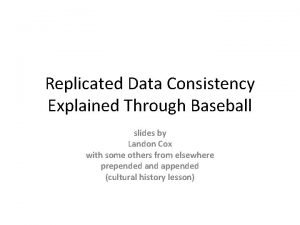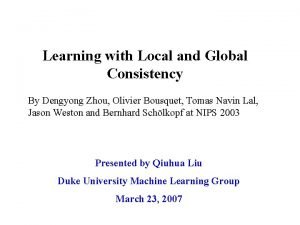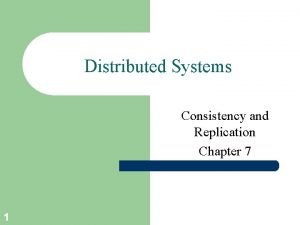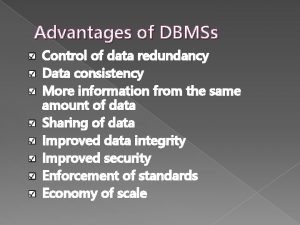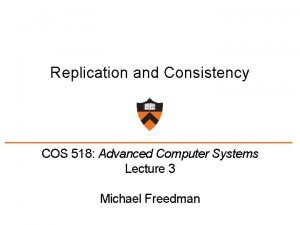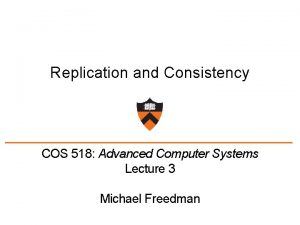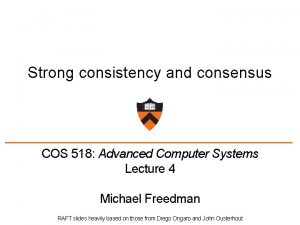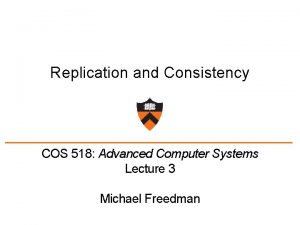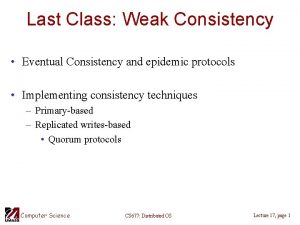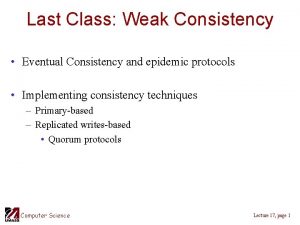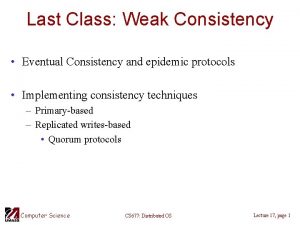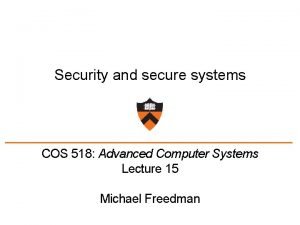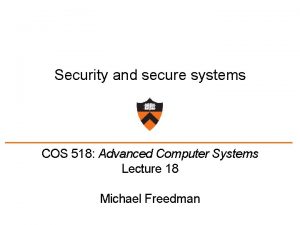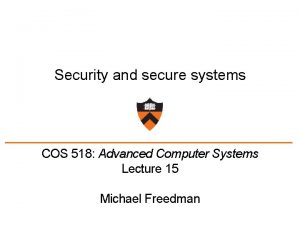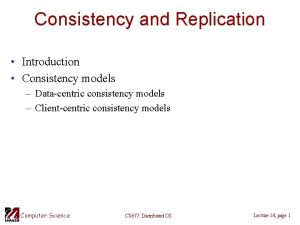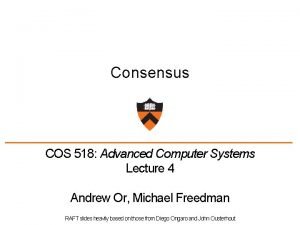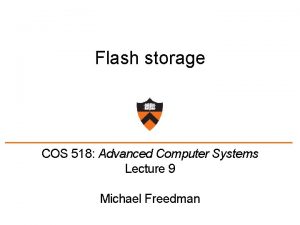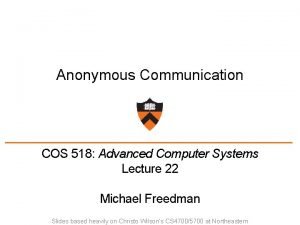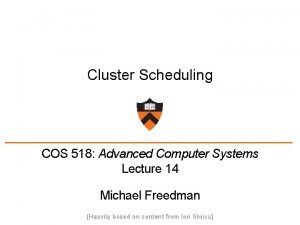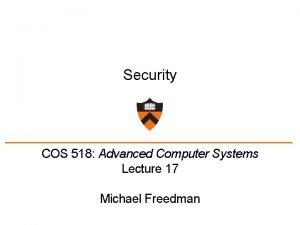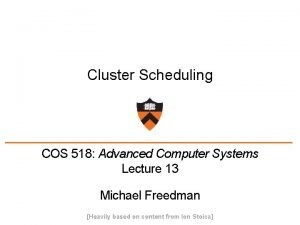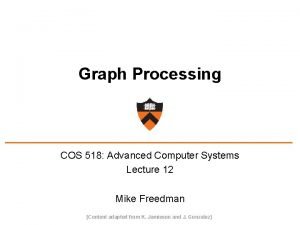Naming and weak consistency COS 518 Advanced Computer































- Slides: 31

Naming and weak consistency COS 518: Advanced Computer Systems Lecture 2 Mike Freedman

Naming and system components Caller Callee • How to design interface between components? • Many interactions involve naming things – Naming objects that caller asks callee to manipulate – Naming caller and callee together 2

Potential Name Syntax • Human readable? – If users interact with the names • Fixed length? – If equipment processes at high speed • Large name space? – If many nodes need unique names • Hierarchical names? – If the system is very large and/or federated • Self-certifying? – If preventing “spoofing” is important 3

Properties of Naming • Enabling sharing in applications – Multiple components or users can name a shared object. – Without names, client-server interface pass entire object by value • Retrieval – Accessing same object later on, just by remembering name • Indirection mechanism – Component A knows about name N – Interposition: can change what N refers to without changing A • Hiding – Hides impl. details, don’t know where google. com located – For security purposes, might only access resource if know name (e. g. , dropbox or Google docs URL –> knowledge gives access) 4

High-level view of naming • Set of possible names • Set of possible values that names map to • Lookup algorithm that translates name to value – Global (context-free) or local names? – Who supplies context? 5

Hierarchical Assignment Processes • Host names: www. cs. princeton. edu – Mnemonic, variable-length, appreciated by humans – Hierarchical, based on organizations – Domain: registrar for each top-level domain (eg, . edu) – Host name: local administrator assigns to each host 6

Hierarchical Assignment Processes • IP addresses: 128. 112. 7. 156 – Numerical 32 -bit address appreciated by routers – Hierarchical, based on organizations and topology – Prefixes: ICANN, regional Internet registries, and ISPs – Hosts: static configuration, or dynamic using DHCP 7

Hierarchical Assignment Processes • MAC addresses: 00 -15 -C 5 -49 -04 -A 9 – Numerical 48 -bit address appreciated by adapters – Non-hierarchical, unrelated to network topology – Blocks: assigned to vendors by the IEEE – Adapters: assigned by the vendor from its block 8

Case Study: Domain Name System (DNS) Computer science concepts underlying DNS • Indirection: names in place of addresses • Hierarchy: in names, addresses, and servers • Caching: of mappings from names to/from addresses 9

Strawman Solution #1: Local File • Original name to address mapping – Flat namespace – /etc/hosts – SRI kept main copy – Downloaded regularly • Count of hosts was increasing: moving from a machine per domain to machine per user – Many more downloads – Many more updates 10

Strawman Solution #2: Central Server • Central server – One place where all mappings are stored – All queries go to the central server • Many practical problems – Single point of failure – High traffic volume – Distant centralized database – Single point of update – Does not scale Need a distributed, hierarchical collection of servers 11

Domain Name System (DNS) • Properties of DNS – Hierarchical name space divided into zones – Distributed over a collection of DNS servers • Hierarchy of DNS servers – Root servers – Top-level domain (TLD) servers – Authoritative DNS servers • Performing the translations – Local DNS servers and client resolvers 12

Distributed Hierarchical Database unnamed root com edu org generic domains bar uk ac zw arpa country domains ac inaddr west east cam 12 foo my usr 34 my. east. bar. edu usr. cam. ac. uk 56

root DNS server for. DNS Queries 3 4 local DNS server dns. princeton. edu a. cs. princeton. edu wants IP address for 2 www. umass. edu local DNS server dns. cs. princeton. edu 1 Recursive vs. Iterative Queries 10 requesting host a. cs. princeton. edu 5 TLD DNS server for. edu 6 9 7 8 authoritative DNS server for umass. edu dns. umass. edu www. umass. edu 14

root DNS server for. DNS Queries 3 • DNS query latency: 4 – e. g. , 1 second • Caching to reduce overhead and delay – Small # of top-level servers, that change rarely – Popular sites visited often 1 • Where to cache? – Local DNS server – Browser 5 TLD DNS server for. edu 6 2 10 requesting host a. cs. princeton. edu 9 7 8 authoritative DNS server for umass. edu dns. umass. edu www. umass. edu 15

Reliability • DNS servers are replicated – Name service available if at least one replica is up – Queries can be load balanced between replicas • UDP used for queries – Need reliability: must implement this on top of UDP • Try alternate servers on timeout – Exponential backoff when retrying same server • Same identifier for all queries – Don’t care which server responds 16

DNS Cache Consistency • Goal: Ensuring cached data is up to date • DNS design considerations – Cached data is “read only” – Explicit invalidation would be expensive • Server would need to keep track of all resolvers caching • Avoiding stale information – Responses include a “time to live” (TTL) field – Delete the cached entry after TTL expires • Perform negative caching (for dead links, misspellings) – So failures quick and don’t overload g. TLD servers 17

Intro to fault tolerant + consistency 18

What is fault tolerance? • Building reliable systems from unreliable components • Three basic steps 1. Detecting errors: discovering presence of an error in a data value or control signal 2. Containing errors: limiting how far errors propagate 3. Masking errors: designing mechanisms to ensure system operates correctly despite error (+ possibly correct error) 19

Why is fault tolerance hard? Failures Propagate • Say one bit in a DRAM fails… • …it flips a bit in a memory address the kernel is writing to. . . • . . . causes big memory error elsewhere, or a kernel panic. . . • . . . program is running one of many distributed file system storage servers. . . • . . . a client can’t read from FS, so it hangs 20

So what to do? 1. Do nothing: silently return the failure 2. Fail fast: detect the failure and report at interface • Ethernet station jams medium on detecting collision 3. Fail safe: transform incorrect behavior or values into acceptable ones • Failed traffic light controller switches to blinking-red 4. Mask the failure: operate despite failure • Retry op for transient errors, use error-correcting code for bit flips, replicate data in multiple places 21

Masking failures • We mask failures on one server via – Atomic operations – Logging and recovery • In a distributed system with multiple servers, we might replicate some or all servers • But if you give a mouse some replicated servers – She’s going to need to figure out how to keep the state of the servers consistent (immediately? eventually? ) 22

Safety and liveness 23

Reasoning about fault tolerance • This is hard! – How do we design fault-tolerant systems? – How do we know if we’re successful? • Often use “properties” that hold true for every possible execution • We focus on safety and liveness properties 24

Safety • “Bad things” don’t happen – No stopped or deadlocked states – No error states • E. g. , mutual exclusion: – Two processes can’t be in critical section at same time 25

Liveness • “Good things” happen – …eventually • Examples – Starvation freedom: process 1 can eventually enter a critical section as long as process 2 terminates – Eventual consistency: if a value in an application doesn’t change, two servers will eventually agree on its value 26

Often a tradeoff • “Good” and “bad” are application-specific • Safety is very important in banking transactions • Liveness is very important in social networking sites 27

Eventual Consistency 28

Eventual consistency • Def’n: If no new updates to the object, eventually all accesses will return the last updated value • Common: git, i. Phone sync, Dropbox, Amazon Dynamo • Why do people like eventual consistency? – Fast read/write of local copy (no primary, no Paxos) – Disconnected operation • Challenges – How do you discover other writes? – How do you resolve conflicting writes? 29

Two prevailing styles of discovery • Gossip pull (“anti-entropy”) – A asks B for something it is trying to “find” – Commonly used for management replicated data • Resolve differences between DBs by comparing digests • Gossip push (“rumor mongering”): – A tells B something B doesn’t know – Gossip for multicasting • Keep sending for bounded period of time: O (log n) – Also used to compute aggregates • Max, min, avg easy. Sum and count more difficult. • Push-pull gossip – Combines both : O(n log n) msgs to spread in O(log n) time

Monday’s readings • Everybody: • E 2 E Arguments in System Design • Signup: • Amazon’s Dynamo • Yahoo!’s PNUTS 31
 Bitcoin
Bitcoin Psalm 161
Psalm 161 Weak acid and weak base reaction
Weak acid and weak base reaction Strong acids
Strong acids Weak acid weak base titration
Weak acid weak base titration Nilai cos dari sudut c adalah
Nilai cos dari sudut c adalah Cos c -cos d formula
Cos c -cos d formula Bentuk perkalian dari cos 2a-cos 4a
Bentuk perkalian dari cos 2a-cos 4a Formulas de arco duplo
Formulas de arco duplo Ritmo narrativo tipi
Ritmo narrativo tipi La struttura di un testo
La struttura di un testo Cos-1a + cos-1b formula
Cos-1a + cos-1b formula Nilai dari 8 sin 112,5° cos 22,5° =
Nilai dari 8 sin 112,5° cos 22,5° = Jika sin a = 3/5 a sudut pada kuadran ii maka cos a =
Jika sin a = 3/5 a sudut pada kuadran ii maka cos a = Fundamentals of cpu in advanced computer architecture
Fundamentals of cpu in advanced computer architecture Advanced topics in computer science
Advanced topics in computer science Advanced computer graphics
Advanced computer graphics Advanced computer forensics
Advanced computer forensics Advanced computer forensics
Advanced computer forensics Dengyong zhou
Dengyong zhou It is the appearance and feel of a surface
It is the appearance and feel of a surface Liquidity index and consistency index
Liquidity index and consistency index Consistency protocols in distributed systems
Consistency protocols in distributed systems Advantages of data redundancy
Advantages of data redundancy Vision eloquence and consistency
Vision eloquence and consistency Naming and writing formulas for acids and bases
Naming and writing formulas for acids and bases Introducing and naming new products and brand extensions
Introducing and naming new products and brand extensions Introducing and naming new products and brand extensions
Introducing and naming new products and brand extensions Naming and writing formulas for acids and bases
Naming and writing formulas for acids and bases Explain the components of computer system
Explain the components of computer system What is computer organization
What is computer organization Input devices
Input devices
